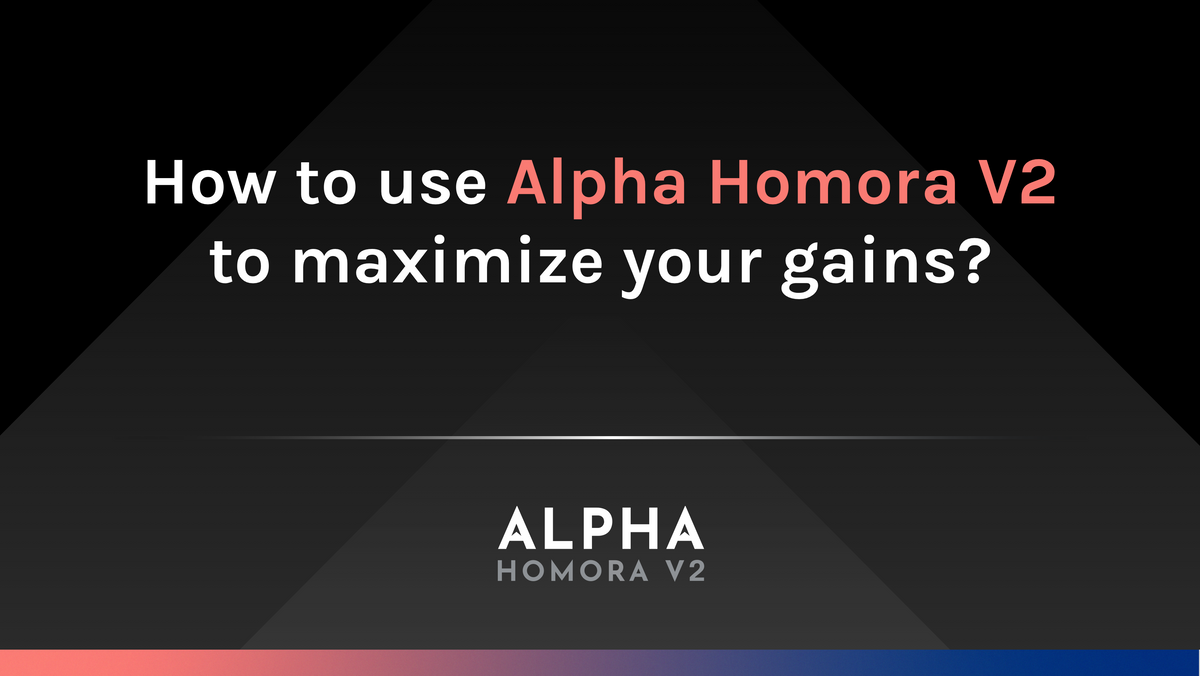How to use Alpha Homora V2 to maximize your gains?

Given the recent launch of Alpha Homora V2 and the start of the migration process from V1 to V2 on Ethereum, we’d like to take this opportunity to educate our users again on how Alpha Homora works and how you should use it to maximize your gains.
Be sure to read this blog so you understand how the product works. If you have read and still don’t understand, feel free to ask for clarification on Discord.
Note that this blog post is in addition to the full documentation that we have on Alpha Homora V1 on Ethereum, V1 on BSC, and V2 on Ethereum.
As with any DeFi product, DeFi users should do research, understand the products, and read the information displayed on the application before confirming any transaction.
What do you need to know to leveraged yield farm on Alpha Homora V2?
Alpha Homora V2 is a leveraged yield farming product that integrates with 4 AMM protocols - Uniswap V2, Sushiswap, Curve, and Balancer.
Alpha Homora V2 adds leveraged functionality to the supported liquidity pools on the underlying AMM, allowing users to easily yield farm on leverage.
As a result, the app’s UI clearly states the AMM name to make sure users know which AMM they are leveraged yield farming on.
For instance, if “Uniswap’s USDC-USDT pool” is selected, the transaction will be executed on the USDC-USDT pool on Uniswap. If “Curve 3pool” is selected, the transaction will be executed on the 3pool on Curve.
Note that the product is designed to not support optimal routing. While optimal routing can be added as an add-on feature, the feature will bring technical complexity. We evaluated the added risks that come with this technical complexity and decided that the feature is not worth adding.
Example of an unfavorable leveraged yield farming position on Alpha Homora V2
Step 1: Supply liquidity
When opening a leveraged position, Alpha Homora V2 allows users to supply any combination of assets. For example, users can supply only USDC, only USDT, only the LP token of Uniswap's USDC-USDT, or a combination of these assets.
Let’s say Henry decides to supply 4,000,000 USDC.
Step 2: Borrow assets
Additionally, Alpha Homora V2 allows users to borrow multiple assets. In this example, Henry can borrow only USDC, only USDT, or a combination of both.
Let’s say Henry selects 7x leverage and borrows 100% in USDC, or 24,000,000 USDC.
Step 3: Read summary before confirming the transaction
As a result of the supplied and borrowed funds, Henry now has 28,000,000 in USDC. If Henry confirms this transaction, Alpha Homora V2 would then optimally swap ~13,300,000 USDC to USDT to ensure Henry has equal value of both assets before supplying the funds to the underlying AMM.
This information is clearly displayed for Henry in the summary section, so he can decide whether to proceed forward.
As you can see, this transaction is not optimal at all since a large amount will be swapped. The “price slippage & trading fees” shown at the bottom also states that this transaction would go through 5.17% price slippage & trading fees.
So what should Henry have done instead? See the next section.
Example of a favorable leveraged yield farming position on Alpha Homora V2
Let’s run through a similar example.
Step 1: Supply liquidity
Henry supplies 4,000,000 USDC.
Step 2: Borrow assets
Henry selects 7x leverage and borrows ~42% in USDC and ~58% in USDT, translating to borrowing 10,000,000 USDC and 14,000,000 USDT.
Step 3: Read summary before confirming the transaction
As a result of the supplied and borrowed funds, Henry now has 14,000,000 in USDC and 14,000,000 in USDT. If Henry confirms this transaction, Alpha Homora V2 would then optimally swap ~6,000 USDC to USDT (since USDC and USDT prices are not exactly 1:1) to ensure Henry has equal value of both assets before supplying the funds to the underlying AMM.
As you can see, this transaction is favorable and preferred over the transaction in the first example. Both the amount to be swapped (6,000 USDC) and the “price slippage & trading fees” (0.0001%) in this second example are significantly lower than those in the first example.
The two examples above show that DeFi users should definitely read all the information shown on the application before confirming the transaction. If there is any unclear information, users should reach out to the project team members to ask for clarification before proceeding.
Closing Thoughts
As the DeFi landscape continues to grow and the complexity behind DeFi protocols increase, education becomes more important than ever.
At Alpha Finance Lab, we take educating users seriously, which is why we show all the information on Alpha Homora V2 application (from specifying the AMM as a part of the name of the leveraged pool - Uniswap’s USDC-USDT - to having a step-by-step breakdown in the last stage before users confirm the transaction).
To continue doing our part better, we will iterate on the UX/UI to display all the information in an easy-to-digest way. Since fine-tuning UX/UI is an ongoing process, please feel free to reach out to us if you have any feedback/suggestions along the way.
While we do our part in displaying as much information as we can in the easiest way possible, users definitely should also do their part in reading the information displayed on the app before confirming the transaction.
About Alpha Finance Lab
Alpha Finance Lab is a DeFi Lab and on a mission to build an ecosystem of DeFi products (the Alpha ecosystem), consisting of innovative building blocks that capture unaddressed demand in key pillars of the financial system. These building blocks will interoperate, creating the Alpha ecosystem that will be an innovative and more capital efficient way to banking in DeFi.
Alpha Homora is Alpha Finance Lab’s first product and DeFi’s first leveraged yield farming product that captures the market gap in lending, one of the key pillars of the financial system.
Join our Telegram/Discord for the latest updates, follow us on Twitter, or read more about us on our Blog and Document!
